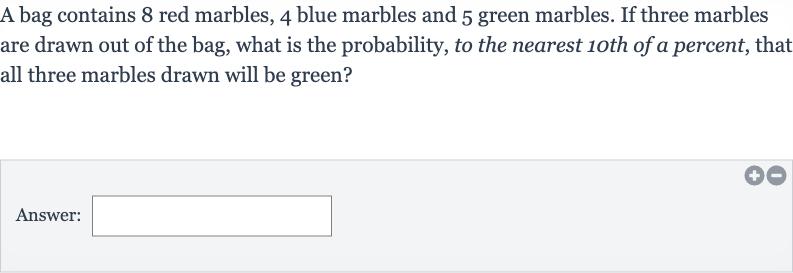AI tutor
Welcome to Bytelearn!
Let’s check out your problem:

A bag contains red marbles, blue marbles and green marbles. If two marbles are drawn out of the bag, what is the probability, to the nearest oth of a percent, that both marbles drawn will be green?Answer:
Full solution
Q. A bag contains red marbles, blue marbles and green marbles. If two marbles are drawn out of the bag, what is the probability, to the nearest oth of a percent, that both marbles drawn will be green?Answer:
- Determine total marbles: Determine the total number of marbles in the bag.The bag contains red marbles, blue marbles, and green marbles. To find the total, add these numbers together.Total marbles = red + blue + green = marbles.
- Calculate green marble probability: Calculate the probability of drawing one green marble. Since there are green marbles out of a total of , the probability of drawing one green marble is .
- Calculate second green marble probability: Calculate the probability of drawing a second green marble after one has already been drawn.After drawing one green marble, there are now green marbles left and a total of marbles in the bag. The probability of drawing a second green marble is now .
- Calculate both events probability: Calculate the probability of both events happening together (drawing two green marbles in a row).To find the probability of both events happening, multiply the probabilities of each event.Probability of both green marbles = .
- Perform multiplication: Perform the multiplication to find the probability.Probability of both green marbles = .
- Simplify fraction: Simplify the fraction to its lowest terms. can be simplified by dividing both the numerator and the denominator by .Simplified probability = .
- Convert to percentage: Convert the probability to a percentage.To convert to a percentage, divide by and then multiply by .Percentage = .
- Perform division and multiplication: Perform the division and multiplication to find the percentage. Percentage = .
- Round to nearest tenth: Round the percentage to the nearest tenth of a percent.Rounded percentage = .
More problems from Percent error: word problems
QuestionGet tutor help
QuestionGet tutor help
QuestionGet tutor help
QuestionGet tutor help
QuestionGet tutor help
